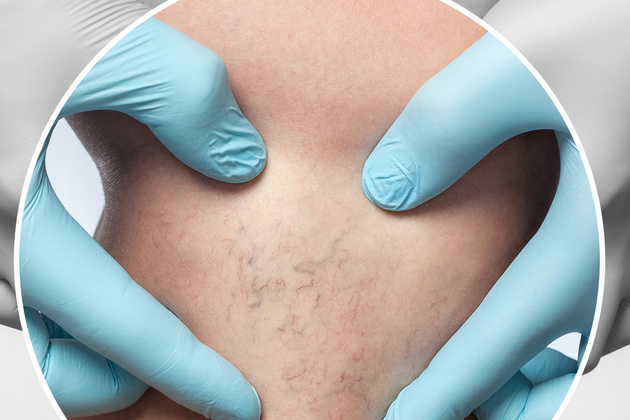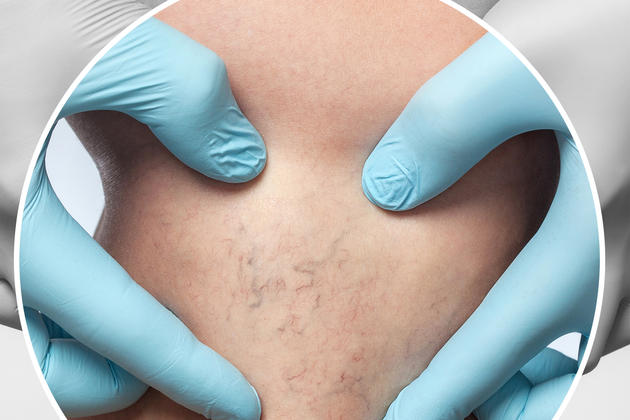What are Varicose Veins: Symptoms, Diagnosis and Treatment
Varicose veins are a common condition seen in millions of people around the world.

Varicose veins are a common condition seen in millions of people around the world. It usually occurs when the veins in the legs become dilated, twisted and swollen. They often appear blue or dark purple in color. In varicose veins, the smooth flow of blood is prevented due to weak or damaged vein walls and valves, causing blood to accumulate in the veins. Varicose veins can be caused by a variety of factors, including genetics, age, pregnancy, obesity, and working standing or sitting for long periods of time. Varicose veins may not be classified as a serious medical condition, but if left untreated, they can lead to more serious problems.
What are Varicose Veins?
Varicose veins are a very common disorder. They are swollen and enlarged, blue or dark purple veins that can be seen under the skin. Although varicose veins can occur in any vein in the body, they are most commonly observed in the legs and especially the calves. If the vessel wall and valves are weakened and damaged, blood cannot flow properly and accumulates in the vessel. As a result, a purple-blue colored curvy vein appearance occurs. Varicose veins can cause pain and look bad aesthetically. Common causes of varicose veins include age, genetic factors, pregnancy, obesity, and prolonged standing or sitting work. Treatment options for varicose veins include wearing compression stockings, lifestyle changes, and medical procedures such as sclerotherapy or surgery.
What are the Symptoms of Varicose Veins?
Symptoms of varicose veins may vary from person to person, but the most common symptoms are:
– Painful, heavy and uncomfortable legs
– Swelling in ankles and feet
– Muscle cramps in the legs, especially at night
– Burning sensation in the legs
– Dry, itchy and thin skin in the area above the varicose veins
– Restless leg syndrome
-Apparently swollen veins
– Small veins, also called spide veins, that can be seen on the skin surface
– Thigh or calf cramp (usually occurs at night)
– Mild swelling in the feet or ankles
– Itching near varicose veins
What Causes Varicose Veins?
Varicose veins are a common condition that can occur in any vein in the body, but they most commonly develop in the legs and feet, especially the calves. This condition occurs when blood accumulates in the veins due to weak or damaged vein walls and valves, preventing proper flow. Common causes of varicose veins include:
Weak or damaged vessel walls and valves
– Wear and tear in the veins and valves due to age
– Varicose veins are genetically present in the family history
– Pregnancy period when blood volume increases and puts pressure on the veins
– Hormonal changes that occur during puberty, pregnancy and menopause
-Obesity condition that puts extra pressure on the veins
– Standing or sitting for long periods of time can cause blood to accumulate in the legs and feet.
Blood clots or other vascular conditions that can damage the valves
– Injuries to the vessels
The above-mentioned conditions prevent blood flow and pave the way for varicose veins.
How Are Varicose Veins Diagnosed?
Varicose veins can be easily detected by physical examination. The physician examines the legs while standing and detects veins that appear swollen. It also asks if there is any pain or discomfort. In some cases, the doctor may recommend a test called a venous Doppler ultrasound of the legs. This non-invasive (does not damage body integrity) test helps detect a blood clot by examining blood flow through valves in the veins using sound waves. This test can also help determine the structure of leg veins and the cause of varicose veins. The physician may also ask about the patient’s medical history, family history, activity levels, and lifestyle. If varicose veins cause pain or discomfort, the physician may recommend treatment options such as compression stockings, lifestyle changes, or medical procedures such as sclerotherapy or surgery.
What are the Varicose Vein Treatment Methods?
There are various treatment methods for varicose veins; These range from minimally invasive procedures to surgical interventions. Some of the most common treatments for varicose veins include:
- Compression Stockings: Compression stockings are a non-invasive treatment option that improves blood circulation in the legs and reduces the risk of varicose veins. By compressing the legs, they help the veins and leg muscles carry blood more effectively.
- Sclerotherapy: Sclerotherapy is a minimally invasive (minimal damage to body integrity) procedure performed by injecting a special solution into the affected vein. The solution causes the vein to scar and redirect blood to a nearby healthy vein. The affected vein eventually collapses and is then absorbed by the body, thus disappearing. Sclerotherapy is especially effective for “spider veins,” which are small varicose veins.
- Endovenous Laser Therapy (EVLT): EVLT is a minimally invasive procedure that uses laser energy to close the affected vein. A laser fiber is inserted into the vein through a small incision, and the laser energy heats the vein and seals it. The blood is then directed to healthy veins.
- Radiofrequency Ablation: Radiofrequency ablation is a minimally invasive procedure that uses radiofrequency energy to heat and close the affected vein. A catheter is inserted into the vein through a small incision and radiofrequency energy heats the vein and seals it. The blood is then directed to healthy veins.
- Ligation and Stripping: Ligation and stripping is a surgical procedure that involves tying off the affected vein and removing it through small incisions. This procedure is often preferred for larger varicose veins that cannot be treated with minimally invasive procedures.
- Micro or Stab Flavbectomy: Micro or stab flevbectomy is a minimally invasive procedure that involves removing surface varicose veins through small incisions. An awl hook removes the vein through the incision. This procedure can be performed in the office under local anesthesia.
What are the Ways to Prevent Varicose Veins?
To prevent the formation or worsening of varicose veins, it may be useful to take the following precautions:
- Regular Exercise: Regular exercise helps prevent the formation of varicose veins by improving blood circulation in the legs. Walking, cycling and swimming are good options. Exercise also helps manage another risk factor for varicose veins, such as obesity.
- Maintaining a Healthy Weight: Maintaining a healthy weight significantly prevents the formation of varicose veins by reducing the pressure on the veins. Obesity is a risk factor for varicose veins, so losing weight may reduce the risk.
- Avoid Prolonged Standing or Sitting: Prolonged standing or sitting can increase the pressure on the veins in the legs and feet and cause varicose veins to form. If you have a job that requires you to sit or stand for long periods of time, take frequent breaks to walk around or stretch your legs. When you’re stuck in the same place, increase circulation by massaging your legs, ankles, and feet.
- Wearing Compression Stockings: Compression stockings improve blood circulation in the legs and help reduce the risk of varicose veins.
- Avoid Tight Clothing: Tight clothing, especially around the waist, groin and legs, can restrict blood circulation and increase the risk of varicose veins. It is necessary to wear loose-fitting clothing to promote proper circulation.
- Elevating Legs High: Elevating your legs above heart level can help reduce pressure on the veins in the legs by improving blood circulation. To do this, lie down and prop your legs up with a pillow or cushion.
If you or your loved ones observe varicose veins, you should consult a healthcare institution to evaluate the situation. Anadolu Health Center, with its expert staff, can treat and follow up varicose veins with the most modern techniques.



